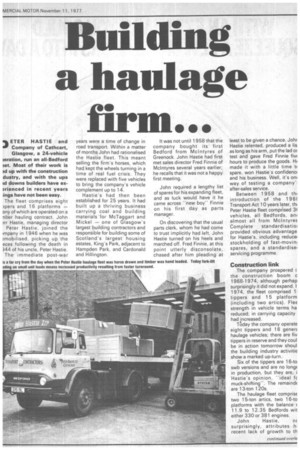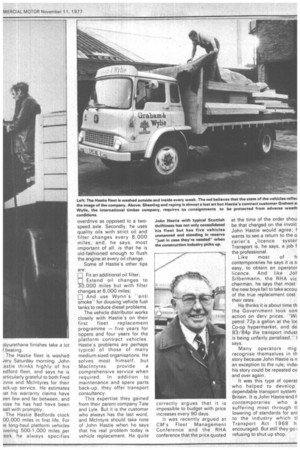Building a haulage firm...
Page 47

Page 48

Page 49

If you've noticed an error in this article please click here to report it so we can fix it.
ETER HASTIE and rd. Company of Cathcart,
Glasgow, a 24-vehicle ieration, run an all-Bedford .et. Most of their work is KI up with the construction dustry, and with the ups id downs builders have ex?rienced in recent years Ings have not been easy. The fleet comprises eight )pers and 16 platforms — any of which are operated on a nber hauling contract. John rr Hastie, managing director Peter Hastie, joined the impany in 1 946 when he was ;mobilised, picking up the eces following the death in 344 of his uncle, Peter Hastie. The immediate post-war years were a time of change in road transport. Within a matter of months John had rationalised the Hastie fleet. This meant selling the firm's horses, which had kept the wheels turning in a time of real fuel crisis. They were replaced with five vehicles to bring the company's vehicle complement up to 14.
Hastie's had then been established for 25 years. It had built up a thriving business carrying coal and building materials 'for McTaggart and Mickel — one of Glasgow's largest building contractors and responsible for building some of Scotland's largest housing estates, King's Park, adjacent to Hampden Park, and Cardonald and Hillington. It was not until 1958 that the company bought its first Bedford from Mclntyres of Greenock. John Hastie had first met sales director Fred Finnie of Mcl ntyres several years earlier; he recalls that it was not a happy first meeting.
John required a lengthy list of spares for his expanding fleet, and as luck would have it he came across "new boy" Finnie on his first day as parts manager.
On discovering that the usual parts clerk, whom he had come to trust implicitly had left, John Hastie turned on his heels and marched off. Fred Finnic, at this point utterly disconsolate, chased after him pleading at least to be given a chance. Johr Hastie relented, produced a is as long as his arm, put the lad or test and gave Fred Finnie fivi hours to produce the goods. Hi made it with a little time ti spare, won Hastie's confidenci and his business. Well, it's oni way of testing a company': after-sales service.
Between 1958 and thi introduction of the 196/ Transport Act 10 years later, thi Peter Hastie fleet comprised 31 vehicles, all Bedfords, ani almost all from McIntyres
Complete standardisatioi provided obvious advantage for Hastie's, including reduce, stockholding of fast-movin, spares, and a standardise, servicing programme.
Construction link The company prospered i the construction boom c 1968-1974, although perhap surprisingly it did not expand. I 1974, the fleet comprised 1, tippers and 15 platform (including two artics). Flee strength in vehicle terms ha reduced; in carrying capacity had ,increased.
Today the company operate eight tippers and 16 genera haulage vehicles; there are fiv tippers in reserve and they coul be in action tomorrow shoul the building industry activitie show a marked up-turn.
Six of the tippers are 16-to swb versions and are no long( in production, but they are, i Hastie's opinion, "ideal fc muck-shifting". The remaind( are 13-ton 120s.
The haulage fleet compris€ two 15-ton artics, two 16-to platforms with the balance ( 11.9 to 12.35 Bedfords wit either 330 or 381 engines.
John Hastie, nc surprisingly, attributes hi recent lack of growth to th ecession in the construction idustry. He estimates that 90 ier cent of his business directly elates to building work; from lie clearing to the delivery of wilding materials.
Six of his vehicles are on lermanent contract to a ;lasgow timber merchant ;raham & Wylie. They are ngaged in delivering ilywoods, wallboards, plastic, loors and window frames hroughout Scotland. The bulk 4 these loads are preloaded at he manufacturing plant on to 'enman swop bodies. This iives an immediate turn-around and eliminates time wasting. Hastie's has operated the Graham & Wylie contract since 1955.
Own maintenance
Although Mclntyres like so many other vehicle distributors offer a comprehensive maintenance and a spare parts back-up service as part of their franchise arrangement, Hastie's prefers to carry out its own repairs. Three fitters are employed on the work which includes engine and gearbox rebuilding. All diesel equipment overhauls go to local specialists Argyll Diesel and M & B Diesel.
John Hastie estimates his annual spares bill to be in the region of £10,000-£11,000. He carries stocks worth between £1,500 and £2,000 although much of this is offset by utilising rebuilt spares from old vehicles.
John Hastie never sells his worn out trucks; they are all broken down for spares with a practical Scottish approach to economy. This policy has been advocated more than once as a protection against cut-rate competition.
Bodybuilding and painting are also carried out "in house' Bodies are aluminium an timber to reduce unladen weigl without losing strength, and the same time giving maximu carrying capacity and reducir overloading problems.
The yellow and brown liver recently changed from gre€ and red, is hand painted to g. in to all the nooks and crannie and, says John Hastie, "It las longer."' He reckons that h craftsmen can produce a toi notch finish using best quail. ICI Dulux followed by a sealin varnish. Although he admi' that the new cornmercii
olyurethane finishes take a lot I beating.
The Hastie fleet is washed very Saturday morning. John astie thinks highly of his edford fleet, and says he is articularly grateful to both Fred innie and Mclntyres for their ack-up service. He estimates at his warranty claims have eon few and far between, and )ose he has had have been ealt with promptly.
The Hastie Bedfords clock 00,000 miles in first life. For ie long-haul platform vehicles pvering 500-1,000 miles per eek he always specifies overdrive as opposed to a twospeed axle. Secondly, he uses quality oils with strict oil and filter changes every 8,000 miles, and, he says, most important of all, is that he is old-fashioned enough to flush the engine at every oil change.
Some of Hastie's other tips are: 111 Fit an additional oil filter; Extend oil changes to 30,000 miles but with filter changes at 6,000 miles;
L] And use Wynn's -anti smokefor dousing vehicle fuel tanks to reduce diesel problems.
The vehicle distributor works closely with Hastie's on their first fleet replacement programme — five years for tippers and four years for the platform contract vehicles. Hastie's problems are perhaps typical of those of many medium-sized organisations. He solves most himself, but Maclntyres provide a comprehensive service when required. In addition to maintenance and spare parts back-up, they offer transport consultancy.
This expertise they gained from their parent company Tate and Lyle. But it is the customer who always has the last word, and McIntyre should take note of John Hastie when he says that his real problem today is vehicle replacement. He quite correctly argues that it is impossible to budget with price increases every 90 days.
It was recently argued at CM's Fleet Management Conference and the RHA conference that the price quoted at the time of the order shou be that charged on the invoic John Hastie would agree; !wants to see a return to the o carer's ,licence syster Transport is, he says, a job f the professional.
Like most of
contemporaries he says it is t( easy, to obtain an operator licence. And like JolSilbermann, the RHA vic chairman, he says that most the new boys fail to take accou of the true replacement cost their rates.
He thinks it is about time th the Government took son action on dery prices. ''Wi petrol 72p a gallon at the loc Co-op hypermarket, and de 83/84p the transport indust is being unfairly penalised,I says.
Many operators mig recognise themselves in th story because John Hastie is n an exception to the rule; indei his story could be repeated ov and over again.
It was this type of operat who helped to develop dependable transport system Britain. It is John Hastie-and contemporaries who a suffering most through tl lowering of standards for ent to the industry which tl Transport Act 1968 h encouraged. But still they go I refusing to shut up shop.
















































































































































































































































